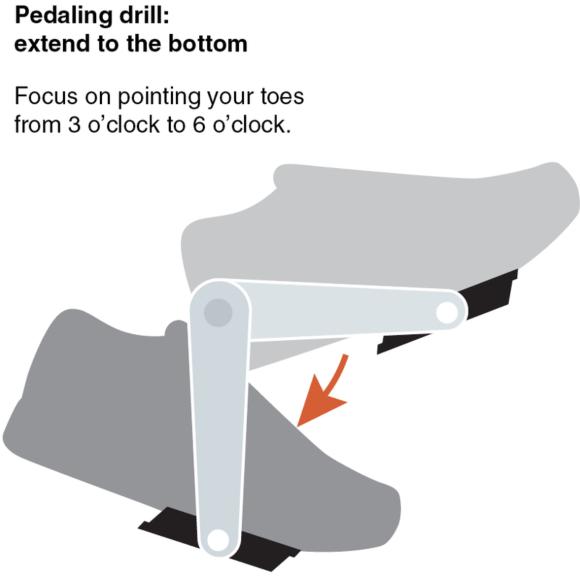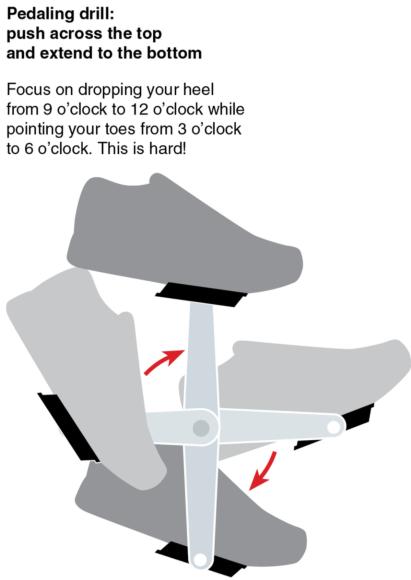Master these pedaling drills
This is an excerpt from Mastering Mountain Bike Skills 3rd Edition by Brian Lopes,Lee McCormack.
You can get fancier and infinitely more complicated drills, but these are our favorite drills for improving pedal stroke. Do these on the trainer and on the road while you're learning (what else is going on?); then, try to fit them into your trail rides. When you start feeling miserable on a climb, this is a great thing to focus on.
Start in the saddle. When you can do these moves sitting, practice them standing.
Drill 1: Push Across the Top
When you push the pedal across the top of the stroke, you start the power phase earlier, and you erase the dead zone at the bottom of the other pedal. Both are good things.
If you want to push your pedal forward, you need to get your foot behind the pedal. You do this by dropping your heel.
- As the pedal passes 9 o'clock, start dropping your heel with the goal of pushing across the top of the stroke.
- Visualize getting your heel below the pedal spindle before 12 o'clock so you can push forward. This probably will never happen, but it's a great goal and a useful visualization.
- Push as soon as you can! Then, push sooner. Use your butt (aka glutes) as much as you can.
- Strive to have your heel lowest at 3 o'clock.
This is the A-1 best, most effective pedaling drill. Master it!
Note: The harder the gear and the slower your cadence, the more heel drop you'll use (and need). Play with different speeds.

When you can consistently drop your heel across the top of the stroke, you're ready for . . .
Drill 2: Extend to the Bottom
From about 3 o'clock to 6 o'clock, your pedal is traveling backward. If you pay attention to your current pedaling at this phase, you'll probably notice that you're pushing the pedal forward. This is a huge waste of energy!
Your goal: Get your foot in front of the pedal, and push the pedal backward to the bottom of the stroke. You do this by pointing your toes.
- As soon as the pedal crosses 3 o'clock, start extending your ankle (pointing your toes).
- Keep extending until 6 o'clock. At this point your toe should be at its lowest point.
- Your heel continues to rise from 6 to 9 o'clock, but that is a function of your knee bending. The main toe-pointing action happens between 3 and 6 o'clock.

This is tricky! Strive for zero down pressure at the bottom of the stroke. You know it's right when the pedal moves backward smoothly and easily. When you can reliably extend your foot into the bottom of the stroke, you're ready for . . .
Drill 3: Both at the Same Time
This is so technically demanding that it's hard to even talk about. Lee has been working on this for years, and this winter, it finally clicked in a big way. As a result, his climbing reached the next level of eternally reduced suckage.
- While one foot is extending, drop the opposite heel.
- While one heel is dropping, extend the opposite foot.
Whoa, man , too much! Feel the opposition. Use the energy of the extending foot to help lift the opposite pedal and drop the opposite heel. Teach your feet to work at the same time. Start at low rpm and work your way up.
This is crazy-insanely-ridiculously tricky! But, it'll help you pedal more smoothly and more powerfully, especially when you're pushing a hard gear out of the saddle.

You don't need to focus on the middle of the power phase.You already know how to mash the pedals down. If you practice the beginning and the end of your power phase, you'll make your power stroke longer and more powerful. You will suck less at pedaling. Heck, you might get great at it!
Learn more about Mastering Mountain Bike Skills, Third Edition.
More Excerpts From Mastering Mountain Bike Skills 3rd EditionSHOP

Get the latest insights with regular newsletters, plus periodic product information and special insider offers.
JOIN NOW
Latest Posts
- Sample mental health lesson plan of a skills-based approach
- Sample assessment worksheet for the skill of accessing valid and reliable resources
- Help your students overcome what holds them back from making health-promoting choices
- Example of an off-season microcycle
- Modifying lifts
- Screening for multilevel programs in a team environment


